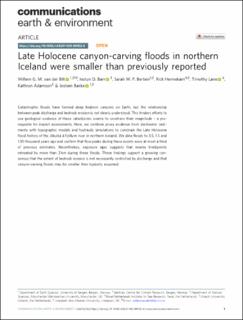Late Holocene canyon-carving floods in northern Iceland were smaller than previously reported
Bilt, Willem Godert Maria van der; Barr, Iestyn D.; Berben, Sarah Miche Patricia; hennekam, rick; Lane, Timothy P.; Adamson, Kathryn; Bakke, Jostein
Journal article, Peer reviewed
Published version

Åpne
Permanent lenke
https://hdl.handle.net/11250/2767719Utgivelsesdato
2021Metadata
Vis full innførselSamlinger
- Department of Earth Science [1048]
- Registrations from Cristin [9748]
Originalversjon
Communications Earth & Environment. 2021, 2, 86. https://doi.org/10.1038/s43247-021-00152-4Sammendrag
Catastrophic floods have formed deep bedrock canyons on Earth, but the relationship between peak discharge and bedrock erosion is not clearly understood. This hinders efforts to use geological evidence of these cataclysmic events to constrain their magnitude – a prerequisite for impact assessments. Here, we combine proxy evidence from slackwater sediments with topographic models and hydraulic simulations to constrain the Late Holocene flood history of the Jökulsá á Fjöllum river in northern Iceland. We date floods to 3.5, 1.5 and 1.35 thousand years ago and confirm that flow peaks during these events were at most a third of previous estimates. Nevertheless, exposure ages suggests that nearby knickpoints retreated by more than 2 km during these floods. These findings support a growing consensus that the extent of bedrock erosion is not necessarily controlled by discharge and that canyon-carving floods may be smaller than typically assumed.
